Anti-Similar Visual Target Tracking Algorithm Based on Filter Peak Guidance and Fusion Network
Abstract
1. Introduction
- (1)
- In this paper, the response value in the kernel correlation filter theory is used as the judgment mechanism, and the judgment mechanism is designed to realize the cross association with the deep learning network. The multi-peak response generated by the filter provides a high-quality template for the Siamese network to capture multiple features about the target from the spatial level, so that the tracking algorithm can better adapt to different target characteristics and environmental conditions, so it can provide reliable tracking results.
- (2)
- Based on the Siamese network, the channel Attention Mechanism is introduced to weight the extracted universal features, so that the features can adaptively focus on the essential information of the target in the process of fusion processing. By fusing the features, the model can comprehensively use the feature information of different levels, and improve the understanding ability and discrimination of the target model.
- (3)
- Considering the effectiveness of the correlation filtering algorithm and the accuracy of the Siamese network, the correlation filtering algorithm tracks first, so that it can adapt to most scenes based on the fusion of color features. In order to avoid the accumulation of errors, it is determined whether the Siamese network is selected as the secondary learning mechanism to find out the potential position of the target in the image. The experimental results show that the proposed algorithm performs well, especially when the target is disturbed by similar objects.
2. Related Works
2.1. Correlation Filter-Based Trackers
2.2. Siamese Network-Based Trackers
2.3. Attention Mechanism
3. Judgment Mechanism Guided by Correlation Filter Response Peaks and Multi-Template Filtering
3.1. Judgment Mechanism
3.2. Multi-Templates Filtering
4. The Proposed Algorithm
4.1. KCF Based on Combined Features
- (1)
- The expression of the appearance model is enhanced, and the HOG and CN features are combined to extract the features of the picture, which can be obtained as
- (2)
- Given a pixel patch (,), the linear regression function is
- (3)
- Performing a cyclic operation on a vector can result in its cyclic matrix, and the calculation formula is:
- (4)
- When the Gaussian kernel is selected for solving, the kernel function can be obtained as follows:
4.2. Siamese Network with Attention Fusion
4.2.1. Backbone Network
4.2.2. Attention Module
4.2.3. Activation Function
4.2.4. The Loss Function
4.3. Overall Tracking Framework
5. Experiments
5.1. Environment and Dataset
5.1.1. Environment
- (1)
- Module selection for Attention Mechanism: In this paper, Channel Attention is used to discriminate the target position in different channels of features, in order to improve the saliency of the target region and reduce the importance of non-target regions.
- (2)
- A basic temporal constraint is incorporated, limiting the object search to a time range of approximately four times the previous size. Additionally, a cosine window is added to the score map to penalize large temporal offsets. To track objects in a large-scale space, the search pattern is processed in several scaled versions. Penalization is applied to changes in all scales, while changes in the current scale are suppressed.
- (3)
- Stride setting: The method with one as the quantization stride does not have an impact on the image containing the object information, but on the network, the score map will be reduced by a multiple after passing through the network. It can be known from the network structure that the convolution and pooling with three layers take two as the quantization step.
5.1.2. Dataset and Evaluation Metrics
- (1)
- Precision is an indicator that measures the overlap between the predicted bounding box and the Groundtruth bounding box of the tracker at a given frame. It represents the accuracy of the tracker on the target position.
- (2)
- Success rate is an indicator that measures the proportion of successful tracking of targets by a tracker across the entire dataset. It indicates whether the tracker’s tracking results on different frames were successful. The success rate is usually calculated by calculating the ratio of the number of frames successfully tracked to the total number of frames.
5.2. Analysis of Experimental Results
5.2.1. Qualitative Analysis
5.2.2. Quantitative Analysis
6. Conclusions
Author Contributions
Funding
Informed Consent Statement
Data Availability Statement
Conflicts of Interest
References
- Wang, J.; Zhu, H.J.I.J.W.M.I.P. Object tracking via dual fuzzy low-rank approximation. Int. J. Wavelets Multiresolution Inf. Process. 2019, 17, 1940003. [Google Scholar] [CrossRef]
- Wang, W.; Xu, H.; Alazab, M.; Gadekallu, T.R.; Han, Z.; Su, C. Blockchain-Based Reliable and Efficient Certificateless Signature for IIoT Devices. IEEE Trans. Ind. Inform. 2022, 18, 7059–7067. [Google Scholar] [CrossRef]
- Ren, S.; Chen, S.; Zhang, W. Collaborative Perception for Autonomous Driving: Current Status and Future Trend. In Proceedings of the 2021 5th Chinese Conference on Swarm Intelligence and Cooperative Control, Singapore, 19–22 November 2021; pp. 682–692. [Google Scholar]
- Xia, R.; Chen, Y.; Ren, B. Improved anti-occlusion object tracking algorithm using Unscented Rauch-Tung-Striebel smoother and kernel correlation filter. J. King Saud Univ. Comput. Inf. Sci. 2022, 34, 6008–6018. [Google Scholar] [CrossRef]
- Wang, J.; Zhu, H.; Yu, S.; Fan, C. Object tracking using color-feature guided network generalization and tailored feature fusion. Neurocomputing 2017, 238, 387–398. [Google Scholar] [CrossRef]
- Bolme, D.S.; Beveridge, J.R.; Draper, B.A.; Lui, Y.M. Visual object tracking using adaptive correlation filters. In Proceedings of the 2010 IEEE Computer Society Conference on Computer Vision and Pattern Recognition, San Francisco, CA, USA, 13–18 June 2010; pp. 2544–2550. [Google Scholar]
- Henriques, J.F.; Caseiro, R.; Martins, P.; Batista, J. High-Speed Tracking with Kernelized Correlation Filters. IEEE Trans. Pattern Anal. Mach. Intell. 2015, 37, 583–596. [Google Scholar] [CrossRef] [PubMed]
- Danelljan, M.; Häger, G.; Khan, F.S.; Felsberg, M. Learning Spatially Regularized Correlation Filters for Visual Tracking. In Proceedings of the 2015 IEEE International Conference on Computer Vision (ICCV), Santiago, Chile, 7–13 December 2015; pp. 4310–4318. [Google Scholar]
- Danelljan, M.; Bhat, G.; Khan, F.S.; Felsberg, M. ECO: Efficient Convolution Operators for Tracking. In Proceedings of the 2017 IEEE Conference on Computer Vision and Pattern Recognition (CVPR), Honolulu, HI, USA, 21–26 July 2017; pp. 6931–6939. [Google Scholar]
- Liu, P.; Du, J.; He, S.; Ren, G. A Real-Time Target Tracking Algorithm Based on Improved Kernel Correlation Filter. In Proceedings of the 2021 5th International Conference on Imaging, Signal Processing and Communications (ICISPC), Kumamoto, Japan, 23–25 July 2021; pp. 5–9. [Google Scholar]
- Du, S.; Wang, S. An Overview of Correlation-Filter-Based Object Tracking. IEEE Trans. Comput. Soc. Syst. 2022, 9, 18–31. [Google Scholar] [CrossRef]
- Hou, W.; Li, H.; Su, J.; Cui, H.; Luo, X. Target tracking algorithm based on image matching and improved kernel correlation filter. In Proceedings of the 2021 International Conference on Electronic Information Engineering and Computer Science (EIECS), Changchun, China, 23–25 September 2021; pp. 252–257. [Google Scholar]
- Hou, Y.; Lin, X.; Li, J. Correlation Filter and Deep Siamese Network Hybrid Algorithm for Visual Object Tracking. In Proceedings of the 2021 6th International Conference on Intelligent Computing and Signal Processing (ICSP), Xi’an, China, 9–11 April 2021; pp. 73–76. [Google Scholar]
- Zhao, F.; Hui, K.; Wang, T.; Zhang, Z.; Chen, Y. A KCF-Based Incremental Target Tracking Method with Constant Update Speed. IEEE Access 2021, 9, 73544–73560. [Google Scholar] [CrossRef]
- Ondrašovič, M.; Tarábek, P. Siamese Visual Object Tracking: A Survey. IEEE Access 2021, 9, 110149–110172. [Google Scholar] [CrossRef]
- Cen, M.; Jung, C. Fully Convolutional Siamese Fusion Networks for Object Tracking. In Proceedings of the 2018 25th IEEE International Conference on Image Processing (ICIP), Athens, Greece, 7–10 October 2018; pp. 3718–3722. [Google Scholar]
- Li, B.; Yan, J.; Wu, W.; Zhu, Z.; Hu, X. High Performance Visual Tracking with Siamese Region Proposal Network. In Proceedings of the 2018 IEEE/CVF Conference on Computer Vision and Pattern Recognition, Salt Lake City, UT, USA, 18–22 June 2018; pp. 8971–8980. [Google Scholar]
- Ren, S.; He, K.; Girshick, R.; Sun, J. Faster R-CNN: Towards Real-Time Object Detection with Region Proposal Networks. IEEE Trans. Pattern Anal. Mach. Intell. 2017, 39, 1137–1149. [Google Scholar] [CrossRef] [PubMed]
- Zhu, Z.; Wang, Q.; Li, B.; Wu, W.; Yan, J.; Hu, W. Distractor-Aware Siamese Networks for Visual Object Tracking. In Proceedings of the Computer Vision—ECCV 2018, Munich, Germany, 8–14 September 2018; pp. 103–119. [Google Scholar]
- Li, B.; Wu, W.; Wang, Q.; Zhang, F.; Xing, J.; Yan, J. SiamRPN++: Evolution of Siamese Visual Tracking with Very Deep Networks. In Proceedings of the 2019 IEEE/CVF Conference on Computer Vision and Pattern Recognition (CVPR), Long Beach, CA, USA, 16–20 June 2019; pp. 4277–4286. [Google Scholar]
- He, K.; Zhang, X.; Ren, S.; Sun, J. Deep Residual Learning for Image Recognition. In Proceedings of the 2016 IEEE Conference on Computer Vision and Pattern Recognition (CVPR), Las Vegas, NV, USA, 26 June–1 July 2016; pp. 770–778. [Google Scholar]
- Wang, Q.; Zhang, L.; Bertinetto, L.; Hu, W.; Torr, P.H.S. Fast Online Object Tracking and Segmentation: A Unifying Approach. In Proceedings of the 2019 IEEE/CVF Conference on Computer Vision and Pattern Recognition (CVPR), Long Beach, CA, USA, 15–20 June 2019; pp. 1328–1338. [Google Scholar]
- Voigtlaender, P.; Luiten, J.; Torr, P.H.S.; Leibe, B. Siam R-CNN: Visual Tracking by Re-Detection. In Proceedings of the 2020 IEEE/CVF Conference on Computer Vision and Pattern Recognition (CVPR), Seattle, WA, USA, 14–19 June 2020; pp. 6577–6587. [Google Scholar]
- Sosnovik, I.; Moskalev, A.; Smeulders, A. Scale Equivariance Improves Siamese Tracking. In Proceedings of the 2021 IEEE Winter Conference on Applications of Computer Vision (WACV), Virtual, 5–9 January 2021; pp. 2764–2773. [Google Scholar]
- Luo, Y.; Cai, Y.; Wang, B.; Wang, J.; Wang, Y. SiamFF: Visual Tracking with a Siamese Network Combining Information Fusion with Rectangular Window Filtering. IEEE Access 2020, 8, 119899–119910. [Google Scholar] [CrossRef]
- Bahdanau, D.; Cho, K.; Bengio, Y.J.C. Neural Machine Translation by Jointly Learning to Align and Translate. Neural machine translation by jointly learning to align and translate. In Proceedings of the 3rd International Conference on Learning Representations, ICLR 2015—Conference Track Proceedings, San Diego, CA, USA, 7–9 May 2015. [Google Scholar]
- Woo, S.; Park, J.; Lee, J.-Y.; Kweon, I.S. CBAM: Convolutional Block Attention Module. In Proceedings of the Computer Vision—ECCV 2018, Munich, Germany, 8–14 September 2018; pp. 3–19. [Google Scholar]
- Bian, T.; Hua, Y.; Song, T.; Xue, Z.; Ma, R.; Robertson, N.; Guan, H. VTT: Long-term Visual Tracking with Transformers. In Proceedings of the 2020 25th International Conference on Pattern Recognition (ICPR), Milan, Italy, 10–15 January 2021; pp. 9585–9592. [Google Scholar]
- Yang, C.; Zhang, X.; Song, Z. CTT: CNN Meets Transformer for Tracking. Sensors 2022, 22, 3210. [Google Scholar] [CrossRef]
- Xing, D.; Evangeliou, N.; Tsoukalas, A.; Tzes, A. Siamese Transformer Pyramid Networks for Real-Time UAV Tracking. In Proceedings of the 2022 IEEE/CVF Winter Conference on Applications of Computer Vision (WACV), Waikoloa, HI, USA, 4–8 January 2022; pp. 1898–1907. [Google Scholar]
- Yu, Y.; Xiong, Y.; Huang, W.; Scott, M.R. Deformable Siamese Attention Networks for Visual Object Tracking. In Proceedings of the 2020 IEEE/CVF Conference on Computer Vision and Pattern Recognition (CVPR), Seattle, WA, USA, 13–19 June 2020; pp. 6727–6736. [Google Scholar]
- Chen, X.; Yan, B.; Zhu, J.; Wang, D.; Yang, X.; Lu, H. Transformer Tracking. In Proceedings of the 2021 IEEE/CVF Conference on Computer Vision and Pattern Recognition (CVPR), Virtual, Online, 19–25 June 2021; pp. 8122–8131. [Google Scholar]
- Yu, B.; Tang, M.; Zheng, L.; Zhu, G.; Wang, J.; Feng, H.; Feng, X.; Lu, H. High-Performance Discriminative Tracking with Transformers. In Proceedings of the 2021 IEEE/CVF International Conference on Computer Vision (ICCV), Montreal, BC, Canada, 11–17 October 2021; pp. 9836–9845. [Google Scholar]
- Gu, F.; Lu, J.; Cai, C. RPformer: A Robust Parallel Transformer for Visual Tracking in Complex Scenes. IEEE Trans. Instrum. Meas. 2022, 71, 5011214. [Google Scholar] [CrossRef]
- Chen, X.; Kang, B.; Wang, D.; Li, D.; Lu, H. Efficient Visual Tracking via Hierarchical Cross-Attention Transformer. In Proceedings of the Computer Vision—ECCV 2022 Workshops, Tel Aviv, Israel, 23–27 October 2022; pp. 461–477. [Google Scholar]
- Liu, Z.; Lin, Y.; Cao, Y.; Hu, H.; Wei, Y.; Zhang, Z.; Lin, S.; Guo, B.J.I.C.I.C.o.C.V. Swin Transformer: Hierarchical Vision Transformer Using Shifted Windows. In Proceedings of the 2021 IEEE/CVF International Conference on Computer Vision (ICCV), Montreal, BC, Canada, 11–17 October 2021; pp. 9992–10002. [Google Scholar]
- Vaswani, A.; Shazeer, N.; Parmar, N.; Uszkoreit, J.; Jones, L.; Gomez, A.N.; Kaiser, L.; Polosukhin, I. Attention Is All You Need. arXiv 2017, arXiv:1706.03762. [Google Scholar]
- Wu, Y.; Lim, J.; Yang, M.H. Object Tracking Benchmark. IEEE Trans. Pattern Anal. Mach. Intell. 2015, 37, 1834–1848. [Google Scholar] [CrossRef] [PubMed]
- Felzenszwalb, P.F.; Girshick, R.B.; McAllester, D.; Ramanan, D. Object Detection with Discriminatively Trained Part-Based Models. IEEE Trans. Pattern Anal. Mach. Intell. 2010, 32, 1627–1645. [Google Scholar] [CrossRef] [PubMed]
- Dalal, N.; Triggs, B. Histograms of oriented gradients for human detection. In Proceedings of the 2005 IEEE Computer Society Conference on Computer Vision and Pattern Recognition (CVPR’05), San Diego, CA, USA, 20–25 June 2005; Volume 881, pp. 886–893. [Google Scholar]
- Kristan, M.; Matas, J.; Leonardis, A.; Felsberg, M.; Cehovin, L.; Fernandez, G.; Vojir, T.; Hager, G.; Nebehay, G.; Pflugfelder, R.; et al. The Visual Object Tracking VOT2015 Challenge Results. In Proceedings of the 2015 IEEE International Conference on Computer Vision Workshop (ICCVW), Santiago, Chile, 11–18 December 2015; pp. 564–586. [Google Scholar]
- Glorot, X.; Bordes, A.; Bengio, Y. Deep Sparse Rectifier Neural Networks. In Proceedings of the Fourteenth International Conference on Artificial Intelligence and Statistics, Proceedings of Machine Learning Research (AISTATS), Lauderdale, FL, USA, 11–13 April 2011; pp. 315–323. [Google Scholar]
- Bertinetto, L.; Valmadre, J.; Henriques, J.; Vedaldi, A.; Torr, P. Fully-Convolutional Siamese Networks for Object Tracking. In Proceedings of the European Conference on Computer Vision(ECCV), Amsterdam, The Netherlands, 11–14 October 2016; pp. 850–865. [Google Scholar]
- Wu, Y.; Lim, J.; Yang, M.H. Online Object Tracking: A Benchmark. In Proceedings of the 2013 IEEE Conference on Computer Vision and Pattern Recognition, Portland, OR, USA, 23–28 June 2013; pp. 2411–2418. [Google Scholar]
- Nam, H.; Han, B. Learning Multi-domain Convolutional Neural Networks for Visual Tracking. In Proceedings of the 2016 IEEE Conference on Computer Vision and Pattern Recognition (CVPR), Las Vegas, NV, USA, 26 June–1 July 2016; pp. 4293–4302. [Google Scholar]
- Guo, D.; Shao, Y.; Cui, Y.; Wang, Z.; Zhang, L.; Shen, C. Graph Attention Tracking. In Proceedings of the 2021 IEEE/CVF Conference on Computer Vision and Pattern Recognition (CVPR), Virtual, 19–25 June 2021; pp. 9538–9547. [Google Scholar]
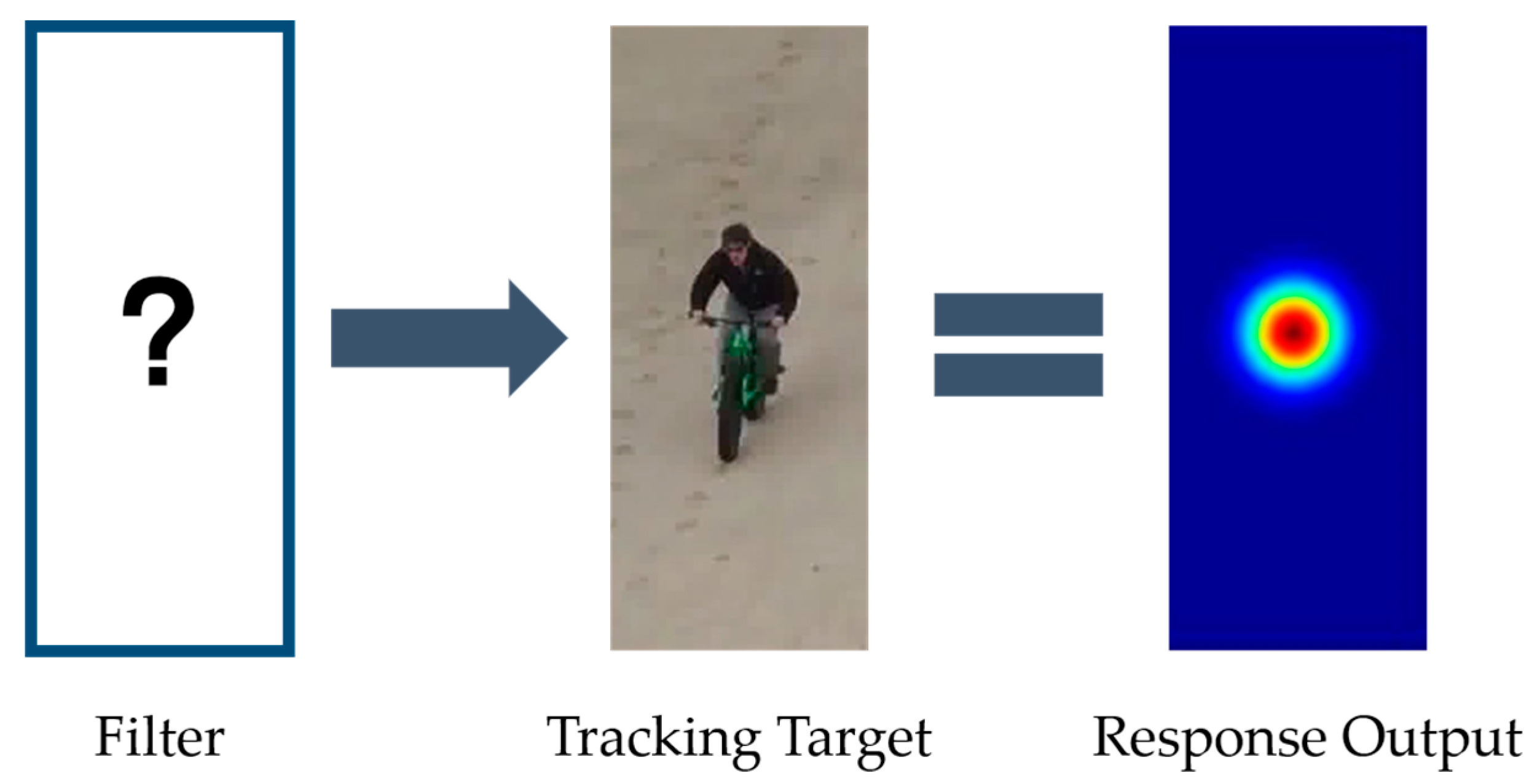
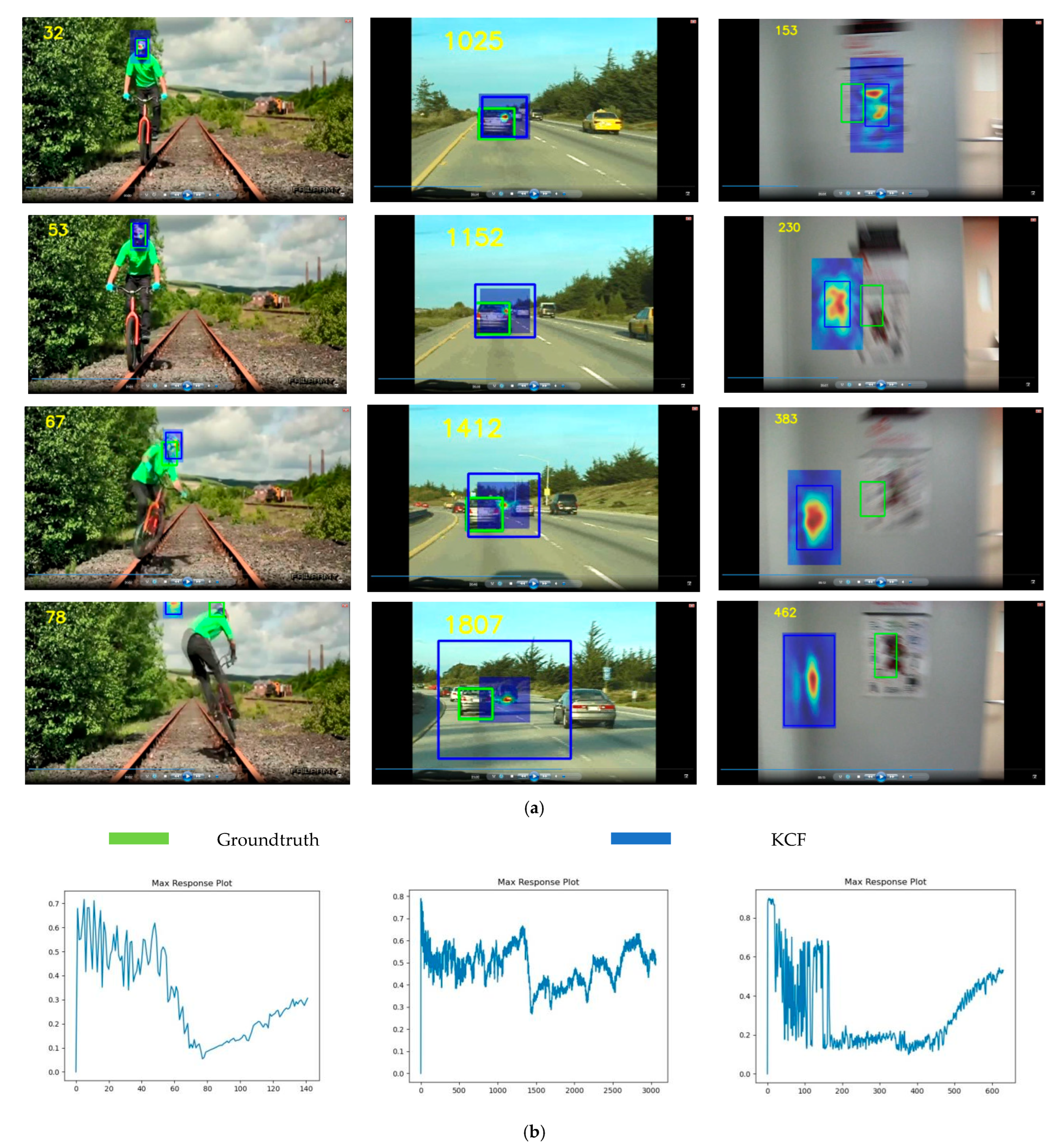


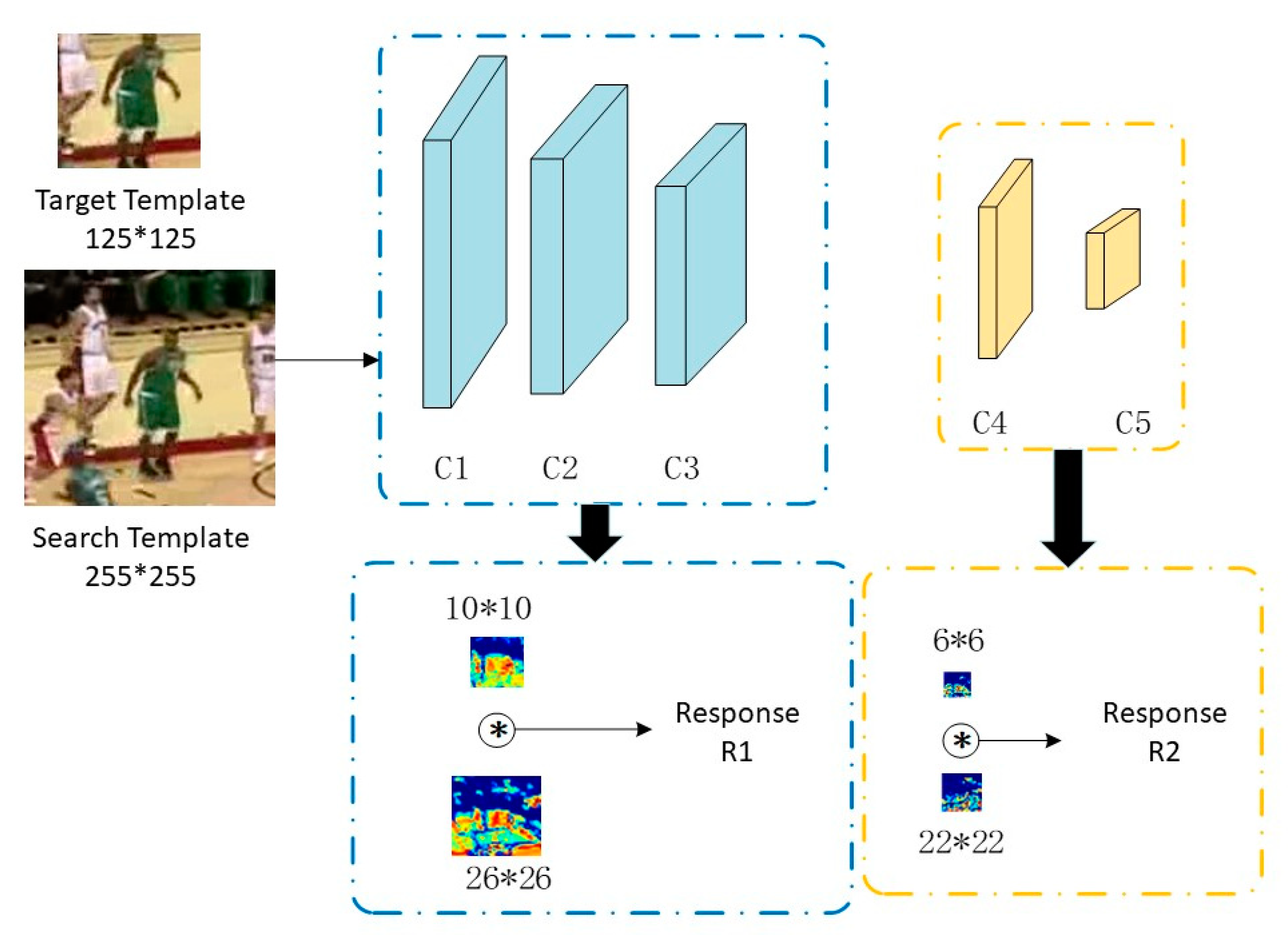



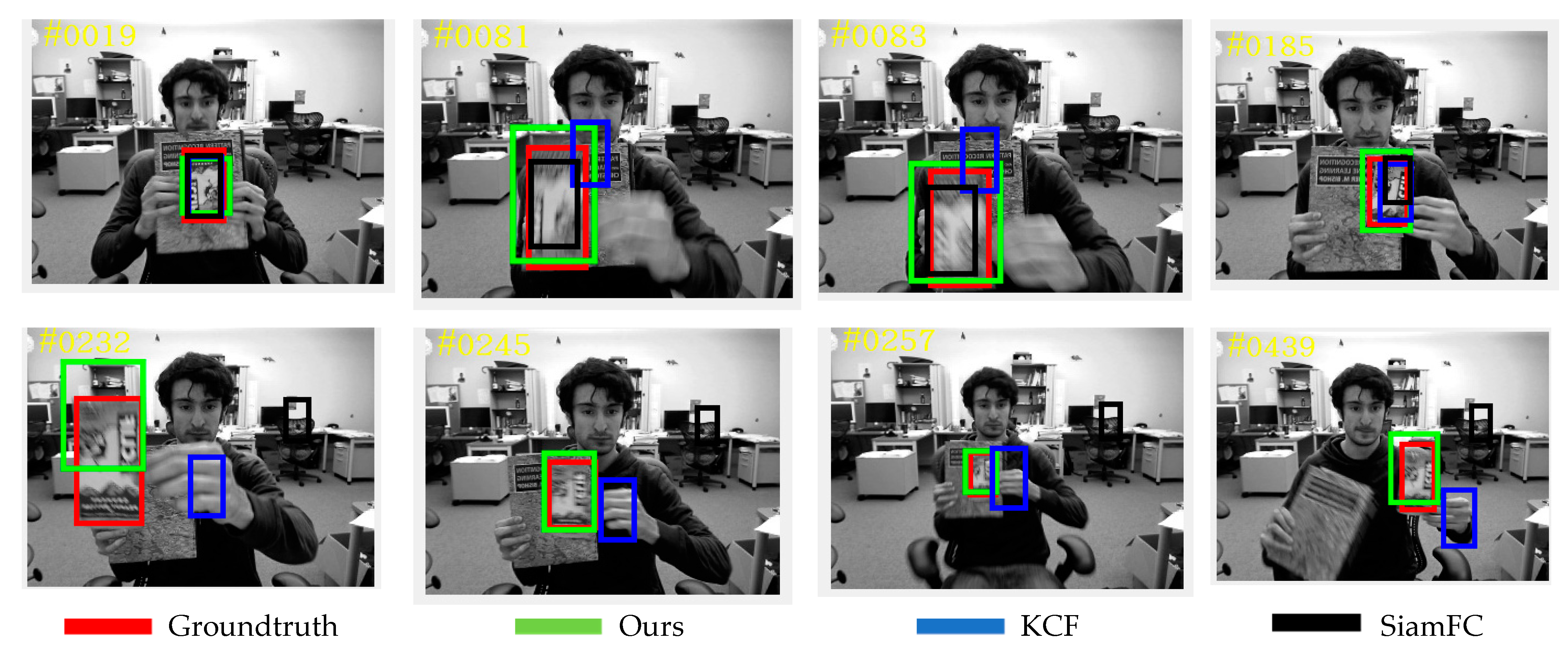

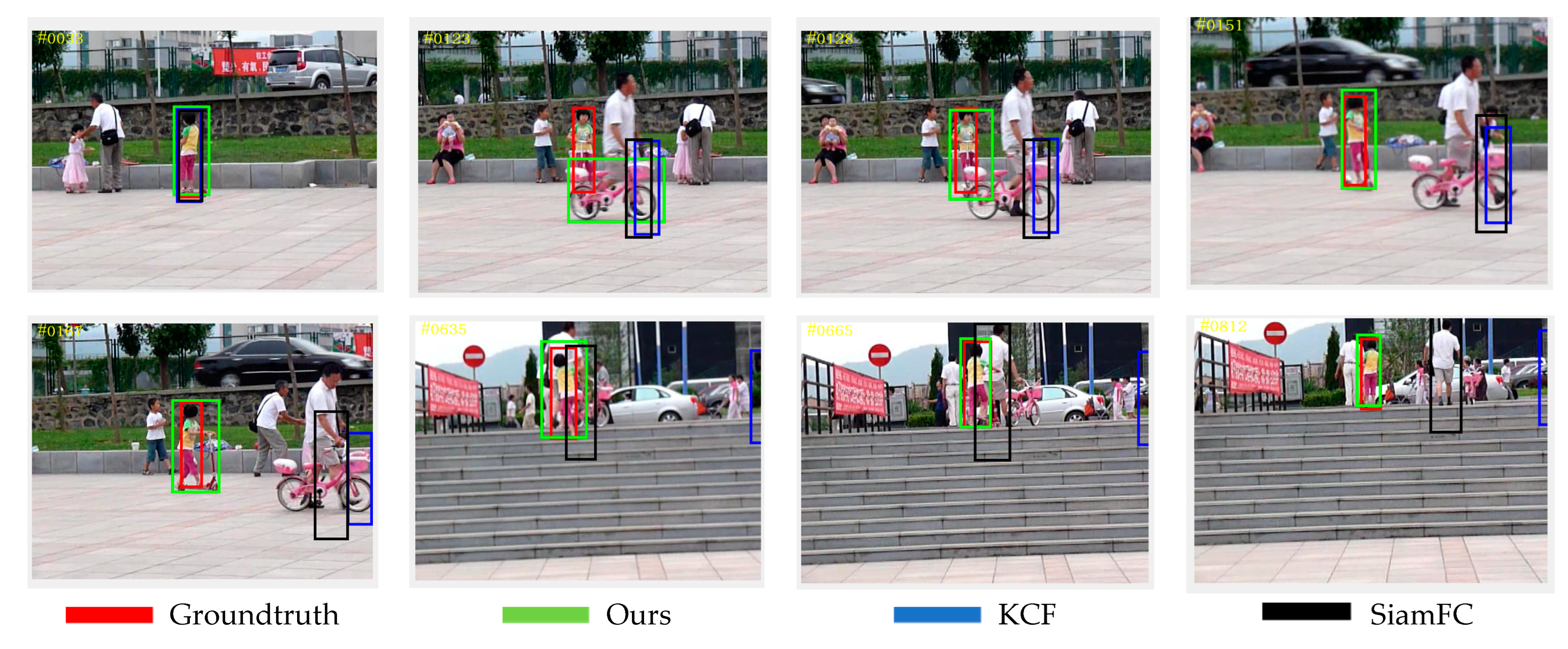



| Layer Name | Convolution Kernel | Stride | Target Template Feature Map Size | Search Template Feature Map Size | Number of Channels |
|---|---|---|---|---|---|
| 127 × 127 | 255 × 255 | 3 | |||
| conv1 | 11 × 11 | 2 | 59 × 59 | 123 × 123 | 96 |
| pool1 | 3 × 3 | 2 | 29 × 29 | 61 × 61 | 96 |
| conv2 | 5 × 5 | 1 | 25 × 25 | 57 × 57 | 256 |
| pool2 | 3 × 3 | 2 | 12 × 12 | 28 × 28 | 256 |
| conv3 | 3 × 3 | 1 | 10 × 10 | 26 × 26 | 192 |
| conv4 | 3 × 3 | 1 | 8 × 8 | 24 × 24 | 192 |
| conv5 | 3 × 3 | 1 | 6 × 6 | 22 × 22 | 128 |
| Video Sequence | KCF | SiamFC | Ours | |||
|---|---|---|---|---|---|---|
| Precision (%) | Success (%) | Precision (%) | Success (%) | Precision (%) | Success (%) | |
| Basketball | 48.0 | 32.7 | 33.6 | 24.7 | 86.3 | 70.9 |
| CarDark | 90.1 | 73.5 | 84.6 | 68.5 | 93.5 | 75.1 |
| BlurCar1 | 89.9 | 64.0 | 76.1 | 71.0 | 90.1 | 88.9 |
| Deer | 29.9 | 26.3 | 56.4 | 49.0 | 81.1 | 67.1 |
| Soccer | 13.7 | 14.4 | 13.1 | 11.9 | 24.2 | 20.8 |
| Bird2 | 57.9 | 49.8 | 84.3 | 72.8 | 87.3 | 75.3 |
| Coke | 69.2 | 55.2 | 77.3 | 59.2 | 87.4 | 79.4 |
| Couple | 31.0 | 27.7 | 89.5 | 68.4 | 94.5 | 90.7 |
| Girl2 | 6.18 | 9.1 | 40.4 | 37.7 | 58.7 | 45.2 |
| Average | 48.4 | 39.2 | 61.7 | 51.5 | 78.1 | 68.2 |
Disclaimer/Publisher’s Note: The statements, opinions and data contained in all publications are solely those of the individual author(s) and contributor(s) and not of MDPI and/or the editor(s). MDPI and/or the editor(s) disclaim responsibility for any injury to people or property resulting from any ideas, methods, instructions or products referred to in the content. |
© 2023 by the authors. Licensee MDPI, Basel, Switzerland. This article is an open access article distributed under the terms and conditions of the Creative Commons Attribution (CC BY) license (https://creativecommons.org/licenses/by/4.0/).
Share and Cite
Wang, J.; Wei, Y.; Wu, X.; Huang, W.; Yu, L. Anti-Similar Visual Target Tracking Algorithm Based on Filter Peak Guidance and Fusion Network. Electronics 2023, 12, 2992. https://doi.org/10.3390/electronics12132992
Wang J, Wei Y, Wu X, Huang W, Yu L. Anti-Similar Visual Target Tracking Algorithm Based on Filter Peak Guidance and Fusion Network. Electronics. 2023; 12(13):2992. https://doi.org/10.3390/electronics12132992
Chicago/Turabian StyleWang, Jing, Yuan Wei, Xueyi Wu, Weichao Huang, and Lu Yu. 2023. "Anti-Similar Visual Target Tracking Algorithm Based on Filter Peak Guidance and Fusion Network" Electronics 12, no. 13: 2992. https://doi.org/10.3390/electronics12132992
APA StyleWang, J., Wei, Y., Wu, X., Huang, W., & Yu, L. (2023). Anti-Similar Visual Target Tracking Algorithm Based on Filter Peak Guidance and Fusion Network. Electronics, 12(13), 2992. https://doi.org/10.3390/electronics12132992





